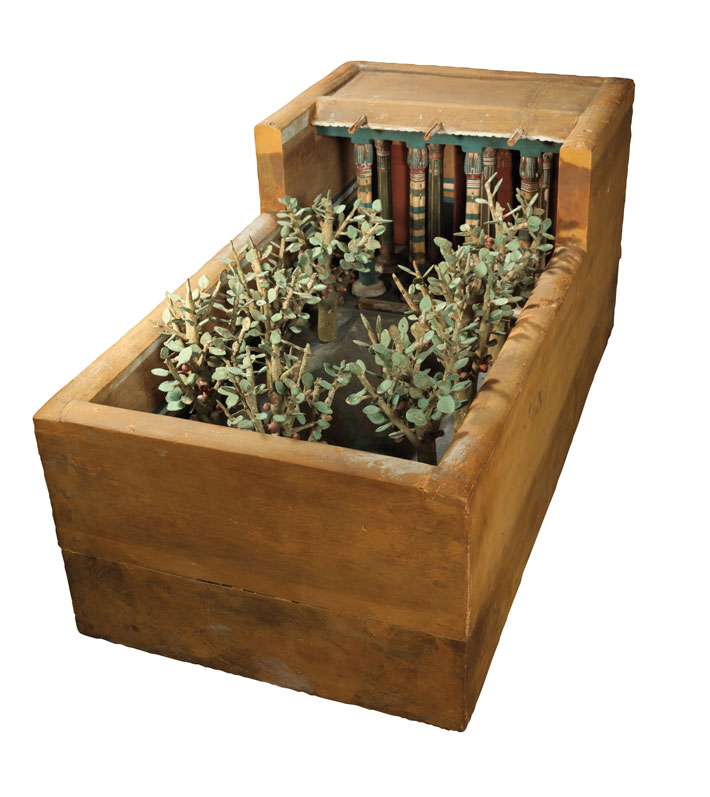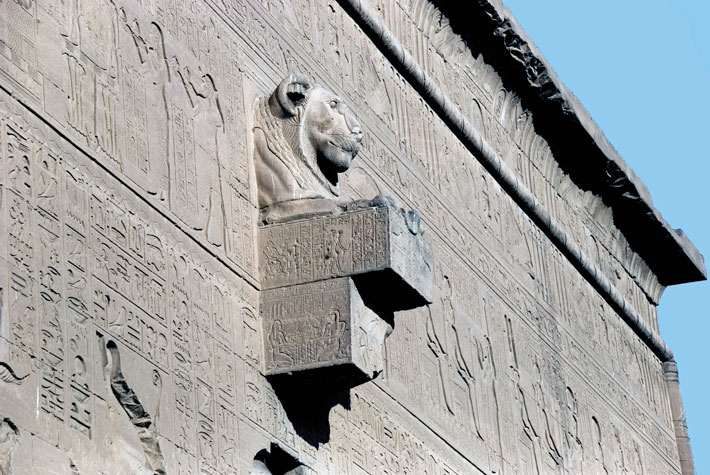When It Rains It Pours
January/February 2024
 It didn’t rain frequently in ancient Egypt, but when it did, says Sapienza University of Rome archaeologist Aneta Skalec, it could come down so violently that it led to legal quarrels between neighbors. Skalec examined a papyrus known as the Demotic Legal Code of Hermopolis West, which was recorded in the time of the pharaoh Ptolemy II Philadelphus (reigned 285–246 B.C.), although its origins are likely centuries earlier. The document contains the most extensive known collection of Egyptian laws, many of them concerning leasing of property and rules of inheritance. “Among the various regulations, we find those concerning neighborly disputes,” Skalec says. “I was surprised when I came across the regulations relating to rain.”
It didn’t rain frequently in ancient Egypt, but when it did, says Sapienza University of Rome archaeologist Aneta Skalec, it could come down so violently that it led to legal quarrels between neighbors. Skalec examined a papyrus known as the Demotic Legal Code of Hermopolis West, which was recorded in the time of the pharaoh Ptolemy II Philadelphus (reigned 285–246 B.C.), although its origins are likely centuries earlier. The document contains the most extensive known collection of Egyptian laws, many of them concerning leasing of property and rules of inheritance. “Among the various regulations, we find those concerning neighborly disputes,” Skalec says. “I was surprised when I came across the regulations relating to rain.”
One passage stipulates how to handle a complaint brought forward by someone whose house is being splashed by rainwater discharged from their neighbor’s roof. The document instructs judges to assess the situation themselves by pouring water through the neighbor’s gutters to determine whether the plaintiff’s grievance is valid. If they determine that it is, then the drainage system of the offending party should be blocked off.
The text is puzzling, in part because there are no known examples of rainwater drainage systems such as the one described in the legal code. Very few excavated ancient Egyptian houses retain their upper stories or roofs—they rarely survive because they would have been constructed from wood, branches, and leaves. “Initially, I was unable to find any archaeological evidence confirming the existence of similar rainspouts in Egypt,” Skalec says. “This motivated me to delve deeper into the topic.”
Skalec noticed that some Egyptian temples, such as the Temple of Edfu in southern Egypt and the Temple of Hathor at Dendera in the center of the country, have waterspouts, often shaped like lion’s heads, designed to channel rainwater from their roofs. While these elements are not quite analogous to the spouts described in the legal code, they do suggest that ancient Egyptians were acquainted with the sort of issues that could arise from heavy rainfall.

The best evidence for the type of gutter system that may have caused the legal imbroglio mentioned in the Hermopolis West papyrus can be found in small models of Egyptian houses that were deposited in tombs. Examples of these models were discovered in the tomb of Meketre, a Middle Kingdom (ca. 2030–1640 B.C.) royal administrator who was buried in Thebes around 1980 B.C. In his tomb, archaeologists discovered 24 wooden models depicting scenes of everyday life. Among them is a model of a house, presumably Meketre’s. The model’s colonnaded facade has a flat roof with three clearly protruding U-shaped rainspouts that appear similar to the offending features described in the code.
After analyzing the miniature facsimile, Skalec determined that during heavy rainfall, water rushing from these spouts could have been discharged with such force, and to such a distance, that it would have splashed onto neighboring properties, which were often separated by just a three-foot-wide street. “There’s no reason to assume that the code regulates a purely theoretical event,” Skalec says. “Such splashing was particularly dangerous due to the fact that Egyptian houses were made of mudbrick, which was not durable and not very resistant to water.” It seems that Egyptian homeowners were right to fear for the structural integrity of their houses and to plead their cases before the courts, lest their homes be washed away due to their neighbors’ negligence.
Advertisement
IN THIS ISSUE
Digs & Discoveries
When It Rains It Pours
A Courtesan’s Prized Possession
Maize Maintenance
Denmark’s Founding Mother
Tracking Ancient Animals
Ice Age Cannibalism
From Hunted to Herded
Divine Dreaming
Legionary Personal Effects
Portrait of an Ancient Ax
Off the Grid: Ambrosio Cave, Cuba
Artifact
Maya toy story
Advertisement

Recent Issues
-
 May/June 2024
May/June 2024
-
 March/April 2024
March/April 2024
-
 January/February 2024
January/February 2024
-
 November/December 2023
November/December 2023
-
 September/October 2023
September/October 2023
-
 July/August 2023
July/August 2023
-
 May/June 2023
May/June 2023
-
 March/April 2023
March/April 2023
-
 January/February 2023
January/February 2023
-
 November/December 2022
November/December 2022
-
 September/October 2022
September/October 2022
-
 July/August 2022
July/August 2022
-
 May/June 2022
May/June 2022
-
 March/April 2022
March/April 2022
-
 January/February 2022
January/February 2022
-
 November/December 2021
November/December 2021
-
 September/October 2021
September/October 2021
-
 July/August 2021
July/August 2021
-
 May/June 2021
May/June 2021
-
 March/April 2021
March/April 2021
-
 January/February 2021
January/February 2021
-
 November/December 2020
November/December 2020
-
 September/October 2020
September/October 2020
-
 July/August 2020
July/August 2020
-
 May/June 2020
May/June 2020
-
 March/April 2020
March/April 2020
-
 January/February 2020
January/February 2020
-
 November/December 2019
November/December 2019
-
 September/October 2019
September/October 2019
-
 July/August 2019
July/August 2019
-
 May/June 2019
May/June 2019
-
 March/April 2019
March/April 2019
-
 January/February 2019
January/February 2019
-
 November/December 2018
November/December 2018
-
 September/October 2018
September/October 2018
-
 July/August 2018
July/August 2018
-
 May/June 2018
May/June 2018
-
 March/April 2018
March/April 2018
-
 January/February 2018
January/February 2018
-
 November/December 2017
November/December 2017
-
 September/October 2017
September/October 2017
-
 July/August 2017
July/August 2017
-
 May/June 2017
May/June 2017
-
 March/April 2017
March/April 2017
-
 January/February 2017
January/February 2017
-
 November/December 2016
November/December 2016
-
 September/October 2016
September/October 2016
-
 July/August 2016
July/August 2016
-
 May/June 2016
May/June 2016
-
 March/April 2016
March/April 2016
-
 January/February 2016
January/February 2016
-
 November/December 2015
November/December 2015
-
 September/October 2015
September/October 2015
-
 July/August 2015
July/August 2015
-
 May/June 2015
May/June 2015
-
 March/April 2015
March/April 2015
-
 January/February 2015
January/February 2015
-
 November/December 2014
November/December 2014
-
 September/October 2014
September/October 2014
-
 July/August 2014
July/August 2014
-
 May/June 2014
May/June 2014
-
 March/April 2014
March/April 2014
-
 January/February 2014
January/February 2014
-
 November/December 2013
November/December 2013
-
 September/October 2013
September/October 2013
-
 July/August 2013
July/August 2013
-
 May/June 2013
May/June 2013
-
 March/April 2013
March/April 2013
-
 January/February 2013
January/February 2013
-
 November/December 2012
November/December 2012
-
 September/October 2012
September/October 2012
-
 July/August 2012
July/August 2012
-
 May/June 2012
May/June 2012
-
 March/April 2012
March/April 2012
-
 January/February 2012
January/February 2012
-
 November/December 2011
November/December 2011
-
 September/October 2011
September/October 2011
-
 July/August 2011
July/August 2011
-
 May/June 2011
May/June 2011
-
 March/April 2011
March/April 2011
-
 January/February 2011
January/February 2011
Advertisement





